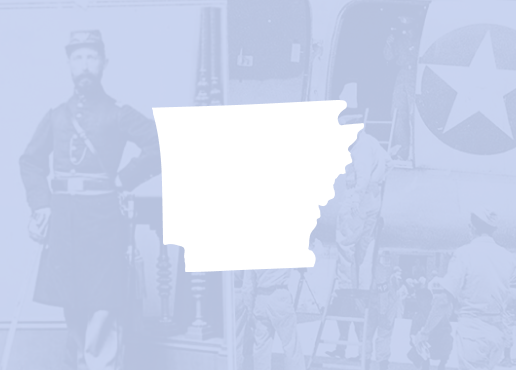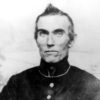calsfoundation@cals.org
Arkansas Peace Society
The Arkansas Peace Society was a loose affiliation of local anti-Confederate groups that formed in response to Arkansas’s secession from the Union. These groups operated like secret societies in several north Arkansas counties until late in 1861, when local militias and the Confederate government of the state began carrying out large-scale arrests of perceived traitors in the region. The Arkansas Peace Society was quickly broken up, though north Arkansas contributed approximately ninety percent of soldiers from the state who fought for the Union, while jayhawkers and bushwhackers also roamed the area with some intensity.
The upland counties of northern Arkansas, where slavery was not a major component of the local economy, contained a large number of people opposed to the Confederacy, and one of the first manifestations of resistance was the formation of the Arkansas Peace Society—also occasionally referred to as the Home Protection Society, Home Guard, and various other names at the time. Van Buren, Izard, Carroll, Fulton, and Marion counties proved the strongholds of resistance. The various groups that fell under the banner of the Arkansas Peace Society had their own constitutions, oaths, passwords, and signs. According to later testimony, a yellow rag or ribbon displayed outside the home was a symbol of that household’s affiliation—thus the Confederate appellation of “yellar rag boys.” Estimates of the total membership of the society reach as high as 1,700, though the names of only 240 are known. The society, though anti-Confederate, did not necessarily form to fight the Confederacy. As historian Ted Worley writes, “The society intended to protect itself at home….Left to itself in peaceful dissent, the brotherhood probably would have been merely a Unionist island of passive resistance.”
But the society was not left alone, in many cases because members openly expressed their feelings about the war. Local citizens’ committees charged with rooting out subversives were the first to take action against the society. Izard County was likely the first to undertake the arrest of supposed society members, imprisoning forty-seven of them. This move inspired Colonel Samuel Leslie, commandant of Searcy County’s militia, to undertake similar actions in his own area, and he soon filled the Burrowville (now Marshall) courthouse with suspects. In December, he marched seventy-eight people in a chain gang south to Little Rock (Pulaski County), a journey that took six days. Twenty-seven suspects from Van Buren County had previously arrived in the capital on November 28, 1861, prompting Governor Henry Massie Rector to write to the Confederate president, Jefferson Davis, for advice on how to proceed. Receiving no response, he wrote to Judah Philip Benjamin, secretary of war for the Confederacy, who urged the governor to use his best judgment. On December 20, 1861, the True Democrat paper reported that the governor confronted the now 117 prisoners and offered them a choice of trial or enlisting in the Confederate army. Only fifteen chose to stand trial. Izard County officials had already been offering Confederate service to prisoners as the means by which “they should wipe out the foul stain” of their resistance and sent many to Colonel Solon Borland’s headquarters in Pocahontas (Randolph County).
Predictably, those pressed into service retained their pro-Union stance and deserted at a higher rate than their fellow soldiers, often attempting either to surrender to Union forces or make their way back home. John Morris, one of the Searcy County chain gang members, saw service at the April 1862 Battle of Shiloh in Tennessee, where his captain, on the first morning of the battle, addressed his troops and said of the former peace society members in their ranks, “If they try to get to the Federals, shoot them; if they fall back, shoot them; if they try to run, shoot them.” Morris was eventually furloughed and made his way back home. He then traveled north to Springfield, Missouri, and was incorporated into the First Arkansas Union Cavalry. Some peace society members who escaped the initial purge also ended up in service of the Union, such as Paris G. Strickland, who first served in the Army of the Southwest and then the First Arkansas.
While Confederates controlled northern Arkansas, most people who held pro-Union sentiments were reluctant to express them. The Arkansas Peace Society stands out as an expression of the conscience and determination of its members. After the Union temporarily secured the region, many area residents were more open with their sympathies.
For additional information:
Johnston, James J. “Arkansas’ 1861 Peace Society.” Arkansas Family Historian 29 (March 1991): 13–29.
———. Mountain Feds: Arkansas Unionists and the Peace Society. Little Rock: Butler Center Books, 2018.
Warren, Luther E. Yellar Rag Boys: The Arkansas Peace Society of 1861 and Other Events in Northern Arkansas, 1861 to 1865. Marshall, AR: Sandra L. Weaver, 1993.
Worley, Ted R. “The Arkansas Peace Society of 1861: A Study in Mountain Unionism.” Journal of Southern History 24 (November 1958): 445–456.
Worley, Ted R., ed. “Documents Relating to the Arkansas Peace Society of 1861.” Arkansas Historical Quarterly 17 (Spring 1958): 82–111.
Staff of the CALS Encyclopedia of Arkansas
 Civil War through Reconstruction, 1861 through 1874
Civil War through Reconstruction, 1861 through 1874 Conscription (Civil War)
Conscription (Civil War) Mountain Federals
Mountain Federals Judah P. Benjamin
Judah P. Benjamin 




The first known Jameson of our lineage is John Jameson, son of John and Martha Jameson, born 1784 in Greenbriar County, VA. Between 1830 and 1840 the family moved to Searcy County, AR. John and Susannah had 13 children. Ebenezar B. Jameson born September 5, 1831, in Washington County, MO, is our great-grandfather. On March 27, 1852, in Searcy County, AR, Ebenezar married Charity Workman born March 20, 1829, in Giles County, TN. During the Civil War when Arkansas seceded from the union, some of the border counties in the northern part of the state were not happy with that decision and formed a “Peace Organization Society.” Ebenezar, two of his brothers, father-in-law John Workman, and other relatives were members. On April 5, 1862, some “Jayhawkers” came to Workman’s home to arrest his stepson, Paris Strickland, who was also a member of the society. Workman was shot and killed by Captain Black of Churchill’s Brigade of Texas Cavalry, CSA. Workman was attempting to hand a gun to his stepson. Several members of the society were captured, chained together, and marched over 100 miles to Little Rock, AR. Many died during the march or as a result of it, including Ebenezar Jameson’s brother, Mastin C. Jameson. At Little Rock, they were given the choice of joining the CSA or being hanged. Ebenezar was conscripted in the Confederate army on Feb. 1, 1863. He was in Co. I, 3rd Arkansas Infantry. He deserted and was captured and kept in prison 3 or 4 months. He escaped and enlisted in the Union army on Nov. 21, 1863 in Pope County, AR. He served as 1st Sergeant, Company “I” 3rd Regiment of the Arkansas Cavalry and was discharged June 12, 1865. The Civil War divided many families and ours was no exception, as one of Charity’s brothers joined the CSA.